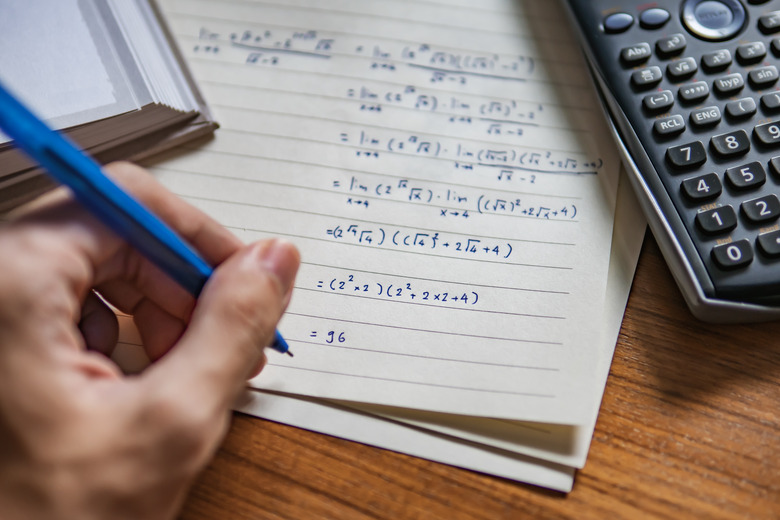How To Solve Linear Equations
Solving linear equations is one of the most fundamental skills an algebra student can master. Most algebraic equations require the skills used when solving linear equations. This fact makes it essential that the algebra student becomes proficient in solving these problems. By using the same process over and over, you can solve any linear equation that your math teacher sends your way.
A Simple Example
1. Move Variables to the Left
Start by moving all of the terms that contain a variable to the left-hand side of the equation. For example, if you are solving
\(5a + 16 = 3a + 22\)
you will move the 3a to the left-hand side of the equation. To do this, you must add the opposite of 3a to both sides. When you add −3a to both sides, you get
\(2a + 16 = 22\)
2. Move Other Terms to the Right
Move the terms that do not contain variables to the right-hand side of the equation. In this example, you will add the opposite of +16 to both sides. This is −16, so you will have
\(2a + 16 – 16 = 22 – 16\)
This gives you
\(2a = 6\)
3. Isolate the Variable
Look at the variable (a) and determine if there are any other operations being performed on it. In this example, it is being multiplied by 2. Do the opposite operation, which is dividing by 2. This gives you
\(\frac{2a}{2} = \frac{6}{2}\)
which simplifies to
\(a = 3\)
4. Check Your Answer
Check your answer for accuracy. To do this, put the answer back in to the original equation.
\(5 × 3 + 16 = 3 × 3 + 24\)
This gives you
\(15 + 16 = 9 + 22\)
This is true, because 31 = 31.
A More Complex Example
1. Move Variables to the Left
Use the same process, even if the equation contains negatives or fractions. For instance, if you are solving
\(\frac{5}{4} x + \frac{1}{2} = 2x – \frac{1}{2}\)
you would begin by moving the 2x to the left-hand side of the equation. This requires you to add the opposite. Since you will be adding it to a fraction (5/4), change the 2 to a fraction with a common denominator (8/4). Add the opposite:
\(\frac{5}{4} x – \frac{8}{4} x + \frac{1}{2} = \frac{8}{4} x – \frac{8}{4} x – \frac{1}{2}\)
which gives
\(\frac{-3}{4} x + \frac{1}{2} = – \frac{1}{2}\)
2. Move Other Terms to the Right
Move the + 1/2 to the right-hand side of the equation. To do this, add the opposite ( −1/2). This gives
\(\frac{-3}{4} x + \frac{1}{2} – \frac{1}{2} = \frac{-1}{2} – \frac{1}{2}\)
which simplifies to
\(-\frac{3}{4} x = -1\)
3. Isolate the Variable
Divide both sides by −3/4. To divide by a fraction, you must multiply by the reciprocal ( −4/3). This gives
\(\frac{-4}{3} × \frac{-3}{4} x = -1 × \frac{-4}{3}\)
which simplifies to
\(x =\frac{4}{3}\)
4. Check Your Answer
Check your answer. To do this, plug 4/3 in to the original equation.
\(\frac{5}{4} × \frac{4}{3} + \frac{1}{2} = 2 × \frac{4}{3} – \frac{1}{2}\)
This gives
\(\frac{5}{3} + \frac{1}{2} = \frac{8}{3} – \frac{1}{2}\)
This is true, because 13/6 = 13/6.
For another example, view the video below:
**Tip:** Using a calculator actually makes solving linear equations longer. If possible, do this work by hand, especially when working with fractions.
**Warning:** Always check your answer. Making mistakes along the way is quite easy when solving linear equations. Checking your answers will ensure that you do not get the problem wrong.
Cite This Article
MLA
Harms, Nicole. "How To Solve Linear Equations" sciencing.com, https://www.sciencing.com/solve-linear-equations-4487348/. 22 December 2020.
APA
Harms, Nicole. (2020, December 22). How To Solve Linear Equations. sciencing.com. Retrieved from https://www.sciencing.com/solve-linear-equations-4487348/
Chicago
Harms, Nicole. How To Solve Linear Equations last modified August 30, 2022. https://www.sciencing.com/solve-linear-equations-4487348/
